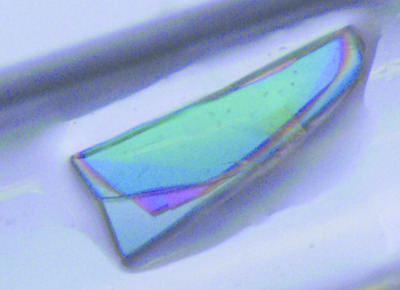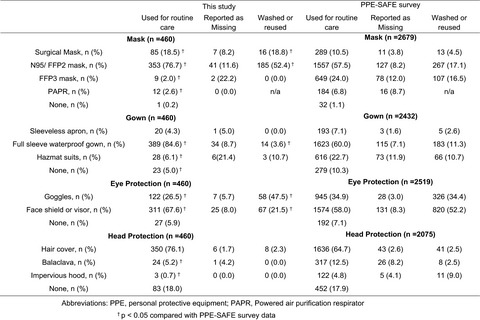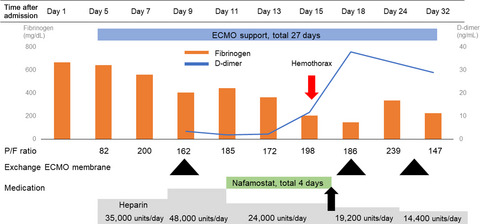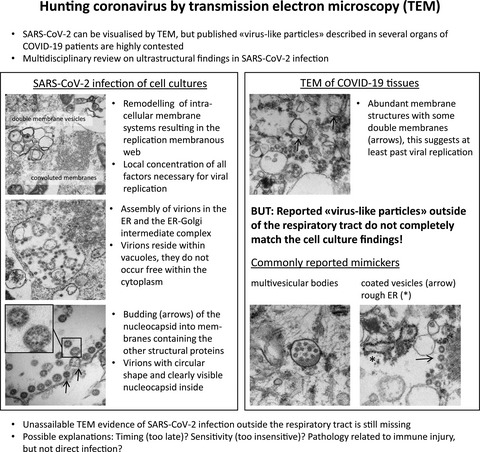Novel Coronavirus Outbreak Sept 25 - Oct 2
Most recent articles (newest articles listed first)
Food Insecurity during COVID-19
Chemie unterrichten und lernen in der Corona‐Zeit – Neue Wege finden!
- CHEMKON
- 207-207
- 10.1002/ckon.202000070
COVID-19's multipronged attack on mental health
Risk factors for myocardial injury in patients with coronavirus disease 2019 in China
- ESC Heart Failure
- 4108-4117
- 10.1002/ehf2.13022
COVID‐19 Therapies in Brazil: Should We Be Concerned with the Impacts on Aquatic Wildlife?
The outcome of COVID‐19 in patients with hematological malignancy
- Journal of Medical Virology
- 1229-1229
- 10.1002/jmv.26576
Peripheral biomarkers' panel for severe COVID-19 patients
- Journal of Medical Virology
- 1230-1232
- 10.1002/jmv.26577
Can you speed up managing a pandemic?
Shifts in alcohol consumption during the COVID‐19 pandemic: early indications from Australia
- Addiction
- 1381-1388
- 10.1111/add.15275
The association of smoking status with SARS‐CoV‐2 infection, hospitalization and mortality from COVID‐19: a living rapid evidence review with Bayesian meta‐analyses (version 7)
- Addiction
- 1319-1368
- 10.1111/add.15276
Are severe asthma patients at higher risk of developing severe outcomes from COVID‐19?
- Allergy
- 959-960
- 10.1111/all.14589
Application of the Health Action Process Approach to Social Distancing Behavior During COVID‐19
Evaluation of the effect of COVID-19 pandemic on anxiety severity of physicians working in the internal medicine department of a tertiary care hospital: a cross-sectional survey
- Internal Medicine Journal
- 1350-1358
- 10.1111/imj.14981
Mitigating strategies and nursing response for cancer care management during the COVID‐19 pandemic: an Italian experience
Leveraging nurse practitioner capacities to achieve global health for all: COVID‐19 and beyond
Influence of blood pressure control and application of renin‐angiotensin‐aldosterone system inhibitors on the outcomes in COVID‐19 patients with hypertension
Being caught in the perfect storm of a diabetes epidemic and the COVID‐19 pandemic: What should we do for our patients?
Graphical Abstract

COVID-19 is spreading rapidly around the world, and the number of related deaths is also increasing. In particular, diabetes patients have shown more severe conditions and a higher mortality rate related to COVID-19, and as no effective treatment or vaccine has been developed yet, efforts to prevent infection are very important. The most important steps to prevent infection are social distancing, wearing a mask and performing proper hand hygiene, and also telemedicine can be used to resolve the physical and psychological barriers to access to medical institutions for diabetes patients.
Rates and characteristics of SARS‐CoV‐2 infection in persons with hepatitis C virus infection
Utility of Deep Brain Stimulation Telemedicine for Patients With Movement Disorders During the COVID-19 Outbreak in China
Pigs are not susceptible to SARS‐CoV‐2 infection but are a model for viral immunogenicity studies
Education during COVID‐19: Ready, headset, go!
Home Sample Self‐Collection for COVID‐19 Patients
Graphical Abstract
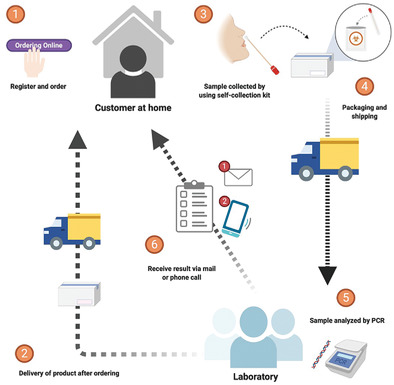
Real-time reverse transcription-polymerase chain reaction using specimens collected from nasopharyngeal and/or oropharyngeal swabs is the standard screening approach for COVID-19; it requires costly laboratory equipment and healthcare professionals that limit its use for large-scale screening of patients. A detailed review of the commercially available self-collection kits is provided and their prospective impact is noted during the current pandemic.
Personal protective equipment use by health‐care workers in intensive care units during the COVID‐19 pandemic in Japan: comparative analysis with the PPE‐SAFE survey
Preventing thrombosis in a COVID‐19 patient by combined therapy with nafamostat and heparin during extracorporeal membrane oxygenation
COVID‐19 is an emergent disease of aging
Graphical Abstract
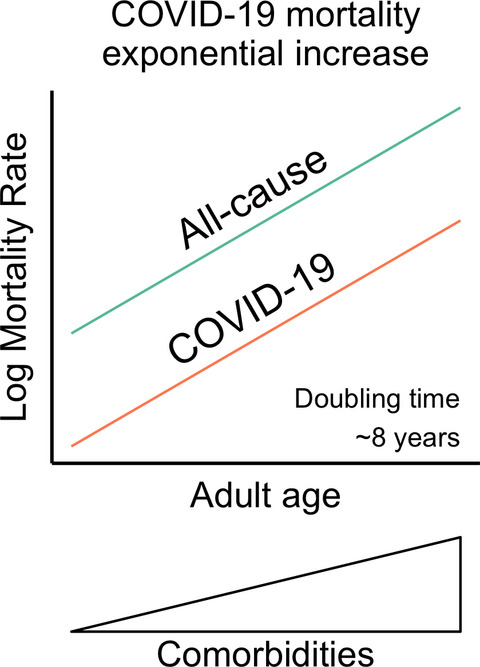
This study establishes COVID-19 as an emergent disease of aging, based on (a) an exponential growth of the COVID-19 mortality rate with age, (b) the COVID-19 mortality rate doubling time approaching that of all-cause human mortality, (c) higher mortality in men than in women, (d) strong association with pre-existing age-related diseases, and (e) COVID-19 being a subset of all-cause pneumonia, which we find itself is a disease of aging.
Correlates of Perceived Physical Activity Transitions during the COVID‐19 Pandemic among Canadian Adults
Vaccine mandate in long‐term care facilities
Negotiated Sharing of Pandemic Data, Models, and Resources
Recognition of the coronavirus disease 2019 pandemic and face mask wearing in patients with Alzheimer's disease: an investigation at a medical centre for dementia in Japan
- Psychogeriatrics
- 923-925
- 10.1111/psyg.12617
Immunosuppression and cardiovascular dysfunction in patients with severe versus mild coronavirus disease 2019: a case series
Graphical Abstract

In addition to pulmonary manifestations, our study demonstrated that other organ systems can also be affected during COVID-19 infection. The injuries in COVID-19 patients could lead to immunosuppression and cardiovascular dysfunction, which might contribute to increased mortality in critically ill patients.
Evidence of central nervous system infection and neuroinvasive routes, as well as neurological involvement, in the lethality of SARS‐CoV‐2 infection
- Journal of Medical Virology
- 1304-1313
- 10.1002/jmv.26570
Coronavirus in human diseases: Mechanisms and advances in clinical treatment
- MedComm
- 270-301
- 10.1002/mco2.26
Graphical Abstract
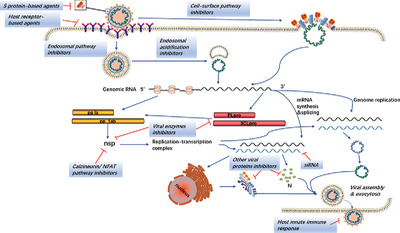
Current mechanisms of anti-CoV therapeutic strategies. The idea to disturb the normal life cycle of the virus provides significant insights into the clinical treatment strategies. All of SARS-CoV, MERS-CoV, and SARS-CoV-2 encode structure proteins (like S protein), nonstructure proteins (eg, PLpro, 3CLpro, RdRp, and helicase), and accessory proteins that are essential for the viral life cycle and that are considered as important targets for the development of antiviral agents. Additionally, enhancement of INF response and several other cell signaling pathways are also regarded as potential anti-CoV strategies.
Management of Obesity in Saudi Arabia During the Era of COVID‐19: A Clash of Two Pandemics
- Obesity
- 18-18
- 10.1002/oby.23055
From lockdown to rāhui and teddy bears in windows: Initial responses to Covid-19 in Aotearoa/New Zealand
Walking the Dog in Madrid During the Pandemic
Brain ischemic injury in COVID‐19‐infected patients: a series of 10 post‐mortem cases
- Brain Pathology
- 205-210
- 10.1111/bpa.12901
SARS‐CoV‐2 spike protein is present in both endothelial and eccrine cells of a chilblain‐like skin lesion
Expecting the unexpected: COVID‐19 in Kidney Transplant Recipients within United Network for Organ Sharing Region 1
- Transplant International
- 1843-1844
- 10.1111/tri.13757
Mesenchymal stem cells prevent overwhelming inflammation and reduce infection severity via recruiting CXCR3+ regulatory T cells
Graphical Abstract
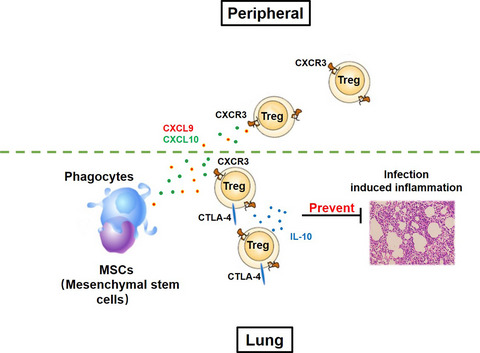
Unlike traditional immunosuppressants, which inadvertently impair a patient's antimicrobial immunity during therapy, mesenchymal stem cells (MSCs) reduce the incidence and duration of respiratory infection. MSCs are phagocytosed by lung cells and recruit CXCR3+ Tregs which could prevent overwhelming inflammation and accelerate bacterial clearance. Our study highlights the application of MSCs in treating patients who need a long-term immunosuppressive regimen.
Molecular and functional resemblance of dexamethasone and quercetin: A paradigm worth exploring in dexamethasone-nonresponsive COVID-19 patients
- Phytotherapy Research
- 3085-3088
- 10.1002/ptr.6886
Abnormally Shallow Boundary Layer Associated With Severe Air Pollution During the COVID‐19 Lockdown in China
Chest computed tomography (CT) features in children with reverse transcription‐polymerase chain reaction (RT‐PCR)‐confirmed COVID‐19: A systematic review
Telehealth for delivery of haemophilia comprehensive care during the COVID‐19 pandemic
- Haemophilia
- 984-990
- 10.1111/hae.14156
Organization of a reference haemophilia unit and its change of activity during the COVID‐19 pandemic
- Haemophilia
- e473-e475
- 10.1111/hae.14160
Lip necrosis in a patient with paroxysmal nocturnal hemoglobinuria: Can it be triggered by COVID‐19?
Vascular emergencies—The new COVID‐19 crisis?
- Journal of Cardiac Surgery
- 2913-2915
- 10.1111/jocs.15072
COVID-19 and congenital heart disease: Cardiopulmonary interactions for the worse!
- Pediatric Anesthesia
- 1160-1161
- 10.1111/pan.14004
Emergency response to COVID-19 epidemic: One Chinese blood centre's experience
Blood supply sufficiency and safety management in Iran during the COVID‐19 outbreak
- Vox Sanguinis
- 175-180
- 10.1111/vox.13012
Safeguarding Children in a Pandemic: Pandemonium with Possibility?
- Child Abuse Review
- 493-496
- 10.1002/car.2654
Impact of lockdown on patients with congestive heart failure during the coronavirus disease 2019 pandemic
- ESC Heart Failure
- 4420-4423
- 10.1002/ehf2.13016
Risk factors for mortality in critically ill patients with COVID‐19 in Huanggang, China: A single‐center multivariate pattern analysis
- Journal of Medical Virology
- 2046-2055
- 10.1002/jmv.26572
Changes in computed tomography findings of COVID‐19 pneumonia: Less extensive lung involvement with decreasing disease prevalence
- Journal of Medical Virology
- 2056-2064
- 10.1002/jmv.26573
Performance evaluation of Panther Fusion SARS‐CoV‐2 assay for detection of SARS‐CoV‐2 from deep throat saliva, nasopharyngeal, and lower‐respiratory‐tract specimens
- Journal of Medical Virology
- 1226-1228
- 10.1002/jmv.26574
Comparison Between Lung Ultrasound and Computed Tomographic Findings in Patients With COVID-19 Pneumonia
Pregnancies recovered from SARS-CoV-2 infection in second or third trimester: obstetric evolution
Points from the SENCo‐Forum
Accuracy of serological testing for SARS‐CoV‐2 antibodies: First results of a large mixed‐method evaluation study
- Allergy
- 853-865
- 10.1111/all.14608
Graphical Abstract
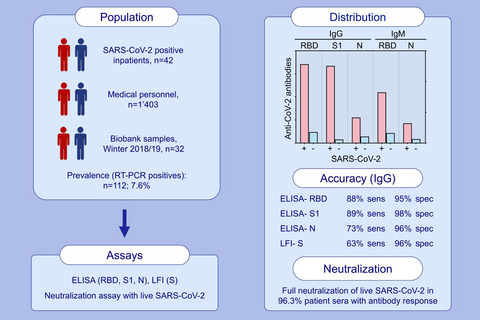
1477 individuals are tested with 4 different serological SARS-CoV-2 immunoassays. ELISA against S1, RBD and N show superior accuracy compared to LFI against S. 96.4% of patient sera that are positive in ELISA show full neutralization of live SARS-CoV-2.
Abbreviations: ELISA, enzyme-linked immunosorbent assay; LFI, lateral flow immunoassay; S1, S1 domain of the spike protein; S, spike protein; sens, sensitivity; spec, specificity; RBD, receptor-binding domain of the spike protein; N, nucleocapsid protein.
A prospective multicentre external validation study of the Liverpool Peritonsillar abscess Score (LPS) with a no‐examination COVID‐19 modification
Superinfections in patients treated with Teicoplanin as anti‐SARS‐CoV‐2 agent
Bilateral facial nerve palsy associated with COVID‐19 and Epstein–Barr virus co‐infection
Graphical Abstract

Bilateral facial palsy is a rare entity, accounting for 0.3 to 2% of all peripheral facial palsies. It can be caused by infections, inflammatory disorders (sarcoidosis), brainstem neoplasias, or can be idiopathic (bilateral Bell's palsy). SARS-CoV-2 adds to the list of infectious agents causative of bilateral facial palsy. Coinfection with SARS-CoV-2 is not rare (in this patient there was evidence of Epstein-Barr virus coinfection) and should be considered in the differential diagnosis.
Muscle involvement in SARS‐CoV‐2 infection
Graphical Abstract
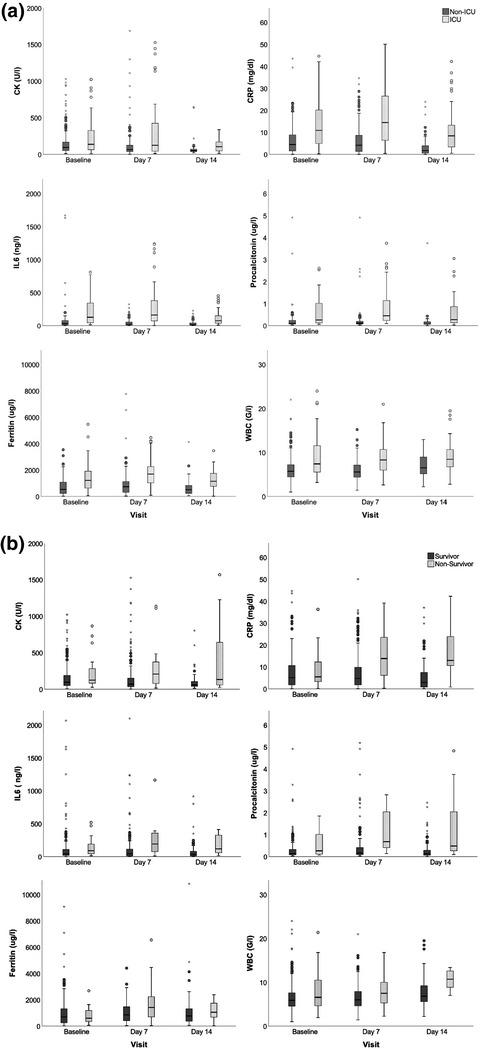
Creatine kinase (CK) levels were compared between mild and severe acute respiratory syndrome coronavirus-2 (SARS-CoV-2) and influenza cases. CK was higher in severe disease and higher in influenza as compared to COVID-19. Although the mechanisms are yet unknown, it appears that SARS-CoV-2 is less myotoxic than the influenza virus.
Nation‐wide analysis of the impact of Covid‐19 pandemic on daily urology practice in Turkey
Lymphopenia in critically ill COVID‐19 patients: A predictor factor of severity and mortality
Leading change during the convergence of an epidemic and a pandemic
- Journal of Advanced Nursing
- 3215-3217
- 10.1111/jan.14567
COVID‐19 in a lung transplant recipient: Exploring the diagnostic role of circulating exosomes and the clinical impact of advanced immunosuppression
COVID-19: a pandemic experience that illuminates potential reforms to health research
Planning for post‐pandemic cancer care delivery: Recovery or opportunity for redesign?
COVID‐19: transplant works toward adaptation
Who is the Most Stressed During the COVID‐19 Pandemic? Data From 26 Countries and Areas
Potential impacts of COVID‐19 on tropical forest recovery
- Biotropica
- 803-807
- 10.1111/btp.12851
COVID‐19 and Immunological Dysregulation: Can Autoantibodies be Useful?
A new UVC‐LED system for disinfection of pathogens generated by toilet flushing
- Indoor Air
- 324-334
- 10.1111/ina.12752
Maintaining Perioperative Safety in Uncertain Times: COVID-19 Pandemic Response Strategies
- AORN Journal
- 397-405
- 10.1002/aorn.13195
Comment on: COVID-19 outbreak and the practice of surgery: do we need to change?
COVID‐19: A Catalyst to Accelerate Global Regulatory Transformation
The Impact of COVID‐19 on Organ Donation, Procurement, and Liver Transplantation in the United States
COVID‐19 reinfection in a healthcare worker
- Journal of Medical Virology
- 4058-4059
- 10.1002/jmv.26565
Development of pancytopenia in a patient with COVID‐19
- Journal of Medical Virology
- 1219-1220
- 10.1002/jmv.26566
Cocirculation of COVID‐19 and dengue: A perspective from Pakistan
- Journal of Medical Virology
- 1217-1218
- 10.1002/jmv.26567
Surveillance and re‐positive RNA test in patients recovered from COVID‐19
- Journal of Medical Virology
- 1221-1224
- 10.1002/jmv.26568
Vitamin D status may indeed be a prognosticator for morbidity and mortality in patients with COVID‐19
- Journal of Medical Virology
- 1225-1225
- 10.1002/jmv.26569
Overexpression of the SARS-CoV-2 receptor ACE2 is induced by cigarette smoke in bronchial and alveolar epithelia
Evaluation of the novel coronavirus disease in Turkish children: Preliminary outcomes
- Pediatric Pulmonology
- 3587-3594
- 10.1002/ppul.25095
Epilepsy and lockdown: A survey of patients normally attending a Spanish centre
COVID‐19 and Venous Thromboembolism in Intensive Care or Medical Ward
Sodium-glucose co-transporter-2 inhibitors and susceptibility to COVID-19: A population-based retrospective cohort study
How to ensure the safety of chemotherapy for advanced cancer patients in the context of new coronavirus?
COVID‐19 elbows: first report in Saudi Arabia
Adjunctive therapies for early withdrawal from extracorporeal membrane oxygenation
- Journal of Cardiac Surgery
- 3671-3672
- 10.1111/jocs.15024
The cytokine storm—An appropriate, over‐reactive response to SARS‐CoV‐2 or the wrong immune pathway?
Treatment of immunocompromised COVID‐19 patients with convalescent plasma
The Multifaceted Impact of COVID‐19 on the Female Academic Emergency Physician: A National Conversation
Binding of SARS‐CoV‐2 to Cell Receptors: A Tale of Molecular Evolution
- ChemBioChem
- 724-732
- 10.1002/cbic.202000618
Graphical Abstract

All together, now: Explicit virus cell interactions are seen between the spike protein and the proteins in the host cell. The collective action of a multitude of weak interactions stabilizes the initial virus cell contact. SARS-COV to SARS-COV-2 mutations are driven by an evolution pressure that leads to enhanced hydrogen bonding.
Mining the past to treat the present, ever mindful of the future: Low‐dose radiotherapy and COVID‐19 pneumonia
- Cancer
- 5017-5021
- 10.1002/cncr.33201
Cancer care and well‐being in adolescents and young adults during the coronavirus disease 2019 pandemic: A UK sarcoma perspective
- Cancer
- 5359-5360
- 10.1002/cncr.33215
COVID‐19 policies in Germany and their social, political, and psychological consequences
Impact of COVID‐19 on Psychology among the University Students
Graphical Abstract
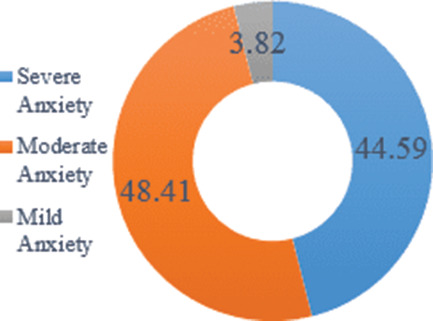
The purpose of this study is to evaluate the psychological impact of the COVID-19 pandemic among university students in Bangladesh. Through cluster sampling and a set of questionnaires based on Generalized Anxiety Disorder Scale (GAD-7), the study attempts to determine the association. The results show that 44.59% are suffering from severe anxiety, 48.41% moderate anxiety, and 3.82% mild anxiety.
A Google–Wikipedia–Twitter Model as a Leading Indicator of the Numbers of Coronavirus Deaths
Risk factors for mortality among patients with SARS‐CoV‐2 infection: A longitudinal observational study
- Journal of Medical Virology
- 2021-2028
- 10.1002/jmv.26560
A bioinformatic prediction of antigen presentation from SARS‐CoV‐2 spike protein revealed a theoretical correlation of HLA‐DRB1*01 with COVID‐19 fatality in Mexican population: An ecological approach
- Journal of Medical Virology
- 2029-2038
- 10.1002/jmv.26561
Retarded decline of the share of SARS‐CoV‐2‐positive children in North Rhine‐Westphalia, Germany
- Journal of Medical Virology
- 2039-2045
- 10.1002/jmv.26564
How to maintain elective treatment of breast cancer during the COVID‐19 pandemic—A cancer center experience
Peripartum cardiomyopathy in a COVID‐19‐infected woman: differential diagnosis with acute myocarditis—A case report from a Hub Institution during the COVID‐19 outbreak
- Echocardiography
- 1673-1677
- 10.1111/echo.14873
Pathophysiology of coronavirus disease 2019 for wound care professionals
- International Wound Journal
- 1935-1940
- 10.1111/iwj.13483
HEALTH: Coronavirus Update
Prosthetic heart valves and the COVID‐19 pandemic era: What should we be concerned about?
- Journal of Cardiac Surgery
- 2500-2505
- 10.1111/jocs.14707
Optimal therapeutic strategy using extracorporeal membrane oxygenation in patients with COVID‐19
- Journal of Cardiac Surgery
- 2872-2873
- 10.1111/jocs.14831
Cardiac surgery during the COVID‐19 sine wave: Preparation once, preparation twice. A view from Houston
- Journal of Cardiac Surgery
- 1615-1623
- 10.1111/jocs.14987
COVID‐19: A perspective from Iran
- Journal of Cardiac Surgery
- 1672-1676
- 10.1111/jocs.15054
The Transaction Costs of Government Responses to the COVID‐19 Emergency in Latin America
Feline infectious peritonitis (FIP) and coronavirus disease 19 (COVID‐19): Are they similar?
Maintaining population health in low‐ and middle‐income countries during the COVID‐19 pandemic: Why we should be investing in Community Health Workers
Provision of COVID-19 Convalescent Plasma in a Resource-Constrained State
- Transfusion
- 2828-2833
- 10.1111/trf.16118
Rapid reorganization of the Milan metropolitan public safety answering point operations during the initial phase of the COVID‐19 outbreak in Italy
Covid-19.bioreproducibility.org: A web resource for SARS-CoV-2-related structural models
- Protein Science
- 115-124
- 10.1002/pro.3959
Military crisis responses to COVID‐19
Allied health service–learning student placements in remote northern Australia during COVID‐19
Characteristics and short‐term obstetric outcomes in a case series of 67 women test‐positive for SARS‐CoV‐2 in Stockholm, Sweden
Comparative optimism about infection and recovery from COVID‐19; Implications for adherence with lockdown advice
- Health Expectations
- 1502-1511
- 10.1111/hex.13134
Hunting coronavirus by transmission electron microscopy – a guide to SARS‐CoV‐2‐associated ultrastructural pathology in COVID‐19 tissues
- Histopathology
- 358-370
- 10.1111/his.14264
Monocyte volumetric parameters and lymph index are increased in SARS‐CoV‐2 infection
Chloroquine and hydroxychloroquine for COVID-19: Perspectives on their failure in repurposing
COVID‐19 and cardiac surgery: A perspective from United Kingdom
- Journal of Cardiac Surgery
- 1649-1658
- 10.1111/jocs.15039
Fear of COVID‐19, psychological distress, work satisfaction and turnover intention among frontline nurses
Student‐led interprofessional influenza vaccination clinic in a time of coronavirus
- Medical Education
- 1078-1079
- 10.1111/medu.14323
PharmGKB Tutorial for Pharmacogenomics of Drugs Potentially Used in the Context of COVID‐19
Antibody seroconversion in asymptomatic and symptomatic patients infected with severe acute respiratory syndrome coronavirus 2 (SARS‐CoV‐2)
Graphical Abstract
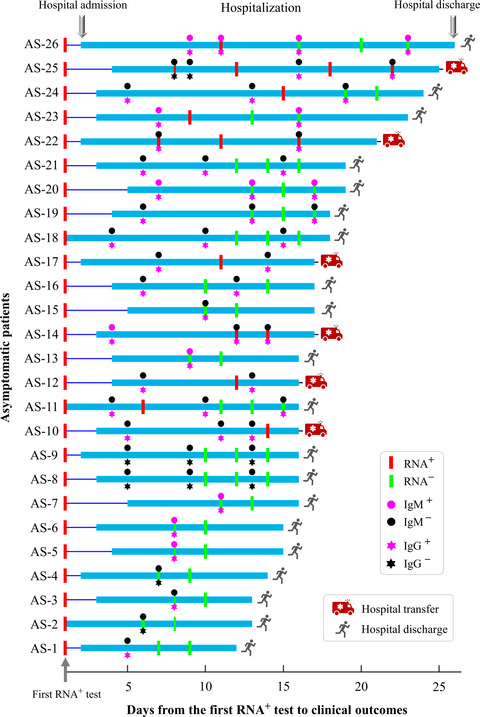
We studied a cohort of 26 asymptomatic and 188 symptomatic patients in a coronavirus field hospital. We found asymptomatic cases, mostly young females ≤ 60 years, in approximately 12% of nonseverely ill cases. More than 90% of cases experienced immunoglobulin M (IgM)/immunoglobulin G (IgG) seroconversion at the time of virus clearance, whereas the median time from the first virus-positive tests to IgG/IgM seroconversion was significantly shorter in asymptomatic than in symptomatic patients. Compared with symptomatic patients, asymptomatic patients had lower IgG/IgM titres and plasma neutralisation capacity at the time of virus clearance.
Initial symptoms of patients with coronavirus disease 2019 in Japan: A descriptive study
Government's policy, citizens' behavior, and COVID-19 pandemic
- Journal of Medical Virology
- 1214-1216
- 10.1002/jmv.26559
Covid‐19: the unimpressive West
Emotion Regulation and Bipolar Disorder: Strategies during the COVID‐19 Pandemic
- Bipolar Disorders
- 879-882
- 10.1111/bdi.13001
Improving precision and power in randomized trials for COVID‐19 treatments using covariate adjustment, for binary, ordinal, and time‐to‐event outcomes
- Biometrics
- 1467-1481
- 10.1111/biom.13377
Innate immunity during SARS‐CoV‐2: evasion strategies and activation trigger hypoxia and vascular damage
Graphical Abstract
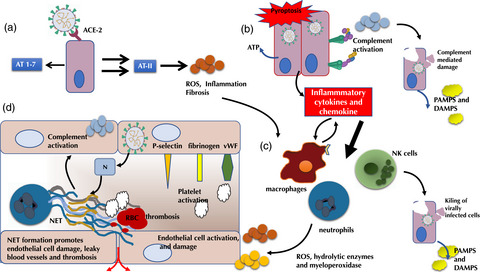
SARS-CoV-2 exploits many strategies to subvert innate immune responses allowing the virus to replicate and disseminate within the host. The extent to which the virus replicates within the host, and the efficacy of the host innate immune response to eradicate the infection and trigger effective adaptive immune responses, but not hyper-responses of innate immunity strongly determines the disease outcome. Understanding the innate immune factors that exacerbate vascular complications following infection will be crucial to control severe disease.
Transfusion requirements in patients with COVID‐19
Development of a personal passive air sampler for estimating exposure to effective chlorine while using chlorine‐based disinfectants
- Indoor Air
- 557-565
- 10.1111/ina.12747
Transmission of SARS‐CoV‐2 by inhalation of respiratory aerosol in the Skagit Valley Chorale superspreading event
- Indoor Air
- 314-323
- 10.1111/ina.12751
Every cloud has a silver lining
Liver transplant in a recently COVID‐19 positive child with hepatoblastoma
COVID‐19: Comparing the applicability of shared room and single room occupancy
The need for an artificial oxygen carrier for disasters and pandemics, including COVID-19
- Transfusion
- 3039-3045
- 10.1111/trf.16122
A Cyclodextrin‐Stabilized Spermine‐Tagged Drug Triplex that Targets Theophylline to the Lungs Selectively in Respiratory Emergency
Graphical Abstract
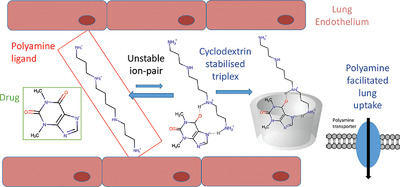
This article demonstrates that ion-pairing theophylline, a drug used in medical emergencies such as status asthmaticus or COVID-19 induced pneumomediastinum, with a polyamine, can direct delivery to the lung. Such an approach is effective when the ion-pair is stabilized as a triplex with cyclodextrin, which increases the in vivo ion-pair life-time to facilitate active accumulation in the lung.
Human Biologists confront the COVID-19 pandemic
COVID‐19 pneumonia and pulmonary microembolism in a patient with B‐thalassemia major
- Clinical Case Reports
- 3138-3141
- 10.1002/ccr3.3275
Graphical Abstract
Swollen heart in COVID‐19 patients who progress to critical illness: a perspective from echo‐cardiologists
- ESC Heart Failure
- 3621-3632
- 10.1002/ehf2.12873
Dynamic emergency department response to the evolving COVID‐19 pandemic: the experience of a tertiary hospital in Singapore
Comparison of the diagnostic efficacy between two PCR test kits for SARS‐CoV‐2 nucleic acid detection
Graphical Abstract
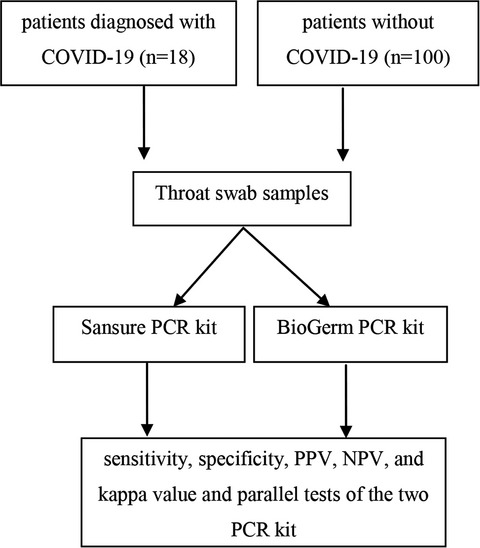
To compare the diagnostic efficacy between two different real-time reverse transcription polymerase chain reaction (RT-PCR) test kits for severe acute respiratory syndrome coronavirus 2 (SARS-CoV-2) nucleic acid detection and provide references for laboratories; Throat swab samples from 18 hospitalized patients were clinically diagnosed with coronavirus disease 2019 (COVID-19) and 100 hospitalized patients without COVID-19 were collected; SARS-CoV-2 nucleic acid was detected in throat swab samples with RT-PCR test kits from Sansure Biotech Inc(Hunan, China) and Shanghai BioGerm Medical Biotechnology Co., Ltd. The sensitivity, specificity, positive predictive value (PPV), negative predictive value (NPV), and kappa value were analyzed, and three parallel tests were performed with three weakly positive samples.
Coronaviruses in farm animals: Epidemiology and public health implications
Graphical Abstract

Animals coronaviruses cause mild to severe infections among farm animals, with high economic and public health impacts for some of them. Increasing demand in animal meat, animal trade and mixing different animal species together foster coronaviruses cross-species transmission and expose human to new coronaviruses.
Covid‐19: From structure to therapeutic targeting in studying approved drugs and local DNA vaccination
Multiple sclerosis and COVID‐19: How many are at risk?
Graphical Abstract
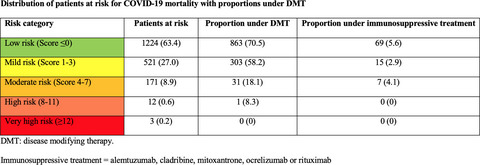
The coronavirus disease 2019 (COVID-19) pandemic challenges neurologists in counseling multiple sclerosis (MS) patients with respect to their risk by severe acute respiratory syndrome coronavirus 2 and in guiding disease-modifying treatment (DMT). Risk of COVID-19 mortality and the respective proportions of patients under DMT and immunosuppressive treatment according to mortality risk were analyzed in a population-based cohort of 1931 MS patients. Only 0.8% of MS patients displayed a high risk of COVID-19 mortality, with less than 1% of these patients receiving DMT or immunosuppressive therapy.


